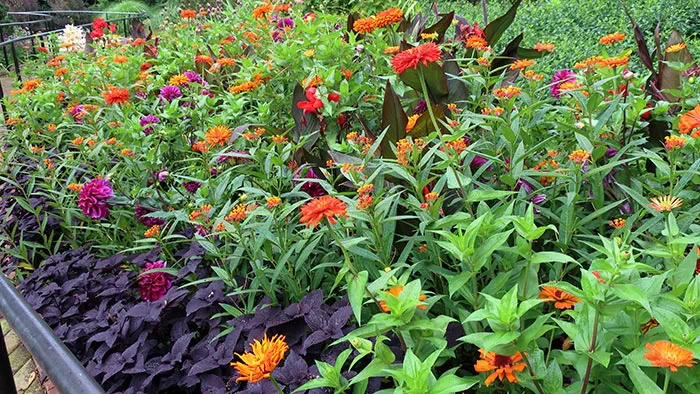Drawings need shadows, music needs bass notes. Similarly, gardens need dark leaves. I'm never one to shy away from a bright plant (or dozen), but I've found that dark foliage adds a depth and definition to planting schemes that you just won't get with anything else. This is particularly true in containers, where every element must be as color saturated as possible. Happily there are annuals, tropicals and tender perennials that exhaust my store of deep, dark adjectives: plum, chocolate, ebony, burgundy, sable, mulberry. Here are a few of the darkest and most desirable.

'Dark Star' coleus hemmed a colorful display of orange 'Inca' zinnias, magenta 'Einstein' dahlias and scarlet-and-yellow 'Red Butterfly' butterfly weed. at the Chicago Botanic Garden in 2018. Dark-leaved, red-flowered canna added depth to the middle of the planting.
Near black
Several elephant ears (Colocasia and Alocasia) offer nearly black leaves, made doubly impressive thanks to their size, with many varieties producing foot-long foliage in one season. These plants must be treated as annuals or wintered indoors in most hardiness zones. Among the dark varieties, favorites include Colocasia esculenta 'Black Magic', 'Diamond Head' and 'Illustris' and Alocasia infernalis 'Kapit', Alocasia plumbea 'Jurassic Dark'.
Some cannas offer dark leaves with a bonus of bright flowers. Good options for dark foliage include Canna 'Australia', which has red flowers, and 'Tropicanna Black', which has orange flowers.
For something unusual, seek out black-leaved cotton, Gossypium herbaceous 'Nigra'. It has matte-black leaves, magenta flowers like little hibiscus and puffy white bolls in late summer.
For shiny dark leaves, see Coprosma 'Cutie' or the easy-to-source 'Black Pearl' ornamental pepper, which adds decorative fruit to the mix in late summer. This matures from bright red to glossy black.
A few easy-care succulents have dark leaves. These include Aeonium arboretum 'Zwartkop' (syn. 'Schwarzkopf'), with glossy black rosettes atop twisting stems; and Echeveria 'Black Prince', with dusty black, green-tinged leaves.
Dark purple
For a dramatic space-filling statement, try a big, dark grass like Allan Armitage's Princess series of Pennisetum purpureum. 'Prince' reaches six feet tall, while 'Princess' reaches four feet and offers a deeper purple color. 'Princess Caroline' and 'Princess Molly' are smaller still.
In a large pot, try the burgundy-leaved four-foot Euphorbia cotinifolia, mixing it with a trail of golden poet's jasmine (Jasminum officinale 'Frojas') and the white-flowering Euphorbia 'Diamond Frost'.)
Hibiscus acetosella is another four-foot burgundy treasure for sunny spots. Its flowers are insignificant, but its maple-like leaves make a great backdrop for lime-leaved coleus or cream-colored dahlias.
Of course, coleus are essential in any discussion of colorful leaves. Outstanding dark varieties include 'Dark Star', 'Blackberry Waffles' and 'Dark Heart', whose colors stay clean and scorch-free even in sun.